
Romanesque architecture is an architectural style of medieval Europe that was predominant in the 11th and 12th centuries. The style eventually developed into the Gothic style with the shape of the arches providing a simple distinction: the Romanesque is characterized by semicircular arches, while the Gothic is marked by the pointed arches. The Romanesque emerged nearly simultaneously in multiple countries ; its examples can be found across the continent, making it the first pan-European architectural style since Imperial Roman architecture. Similarly to Gothic, the name of the style was transferred onto the contemporary Romanesque art.

Cathedrals, collegiate churches, and monastic churches like those of abbeys and priories, often have certain complex structural forms that are found less often in parish churches. They also tend to display a higher level of contemporary architectural style and the work of accomplished craftsmen, and occupy a status both ecclesiastical and social that an ordinary parish church rarely has. Such churches are generally among the finest buildings locally and a source of regional pride. Many are among the world's most renowned works of architecture. These include St Peter's Basilica, Notre-Dame de Paris, Cologne Cathedral, Salisbury Cathedral, Antwerp Cathedral, Prague Cathedral, Lincoln Cathedral, the Basilica of Saint-Denis, Santa Maria Maggiore, the Basilica of San Vitale, St Mark's Basilica, Westminster Abbey, Saint Basil's Cathedral, Antoni Gaudí's incomplete Sagrada Família and the ancient cathedral of Hagia Sophia in Istanbul, now a mosque.

The Basilica of Saint Francis of Assisi is the mother church of the Roman Catholic Order of Friars Minor Conventual in Assisi, a town in the Umbria region in central Italy, where Saint Francis was born and died. It is a papal minor basilica and one of the most important places of Christian pilgrimage in Italy. With its accompanying friary, Sacro Convento, the basilica is a distinctive landmark to those approaching Assisi. It has been a UNESCO World Heritage Site since 2000.
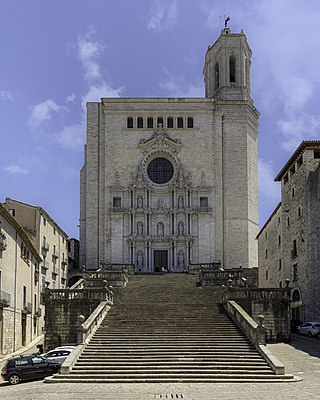
The Cathedral of Saint Mary,, is a Roman Catholic cathedral located in Girona, Catalonia, Spain. It is the seat of the Roman Catholic Diocese of Girona.

Italian Gothic architecture (also called temperate Gothic architecture, has characteristics that distinguish it considerably from those of the place of origin of Gothic architecture, France, and from other European countries in which this language has spread.

Portuguese Gothic architecture is the architectural style prevalent in Portugal in the Late Middle Ages. As in other parts of Europe, Gothic style slowly replaced Romanesque architecture in the period between the late 12th and the 13th century. Between the late 15th and early 16th century, Gothic was replaced by Renaissance architecture through an intermediate style called Manueline.
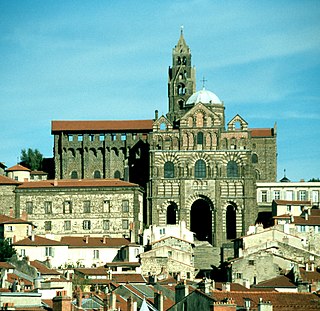
Le Puy Cathedral is a Catholic church located in Le Puy-en-Velay, in the French region of Auvergne. The cathedral is a national monument. It has been a centre of pilgrimage in its own right since before the time of Charlemagne, as well as being a stopover on the pilgrimage route to Santiago de Compostela. Since 1998 it has been part of a multi-location UNESCO World Heritage Site along France's Santiago pilgrimage routes. It is the seat of the Bishop of Le Puy.

San Francesco is a 13th-century, Roman Catholic church located on via Berrettini in Cortona, region of Tuscany, Italy.
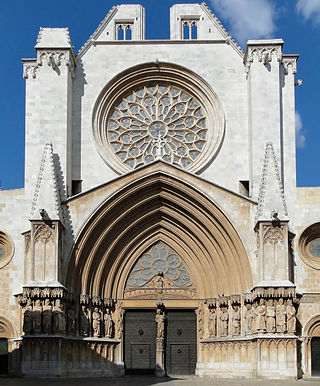
The Primatial Cathedral of Tarragona is a Roman Catholic church in Tarragona, Catalonia, Spain. The edifice is located in a site previously occupied by a Roman temple dating to the time of Tiberius, a Visigothic cathedral, and a Moorish mosque. It was declared a national monument in 1905.

The Basilica of St Francis is a parish church and minor basilica located on Piazza San Francesco #6 in Viterbo, region of Lazio, Italy. The museological management of the church is run by the Polo Museale del Lazio. The church is just northeast of the Piazza della Rocca Albornoz, just diagonally behind the Palazzo Grandori, at the northern edge of historic Viterbo.

San Giovanni Evangelista is a Mannerist-style, Roman Catholic church located on Piazzale San Giovanni, located just behind the apse of the Parma Cathedral, in the historic center of Parma, northern Italy. The buildings surrounding the piazza were also part of a former Benedictine convent. The church is notable for its Correggio frescoes.

The church dedicated to saint Francis of Assisi, known for centuries as San Francesco Grande is a religious building on the Via San Francesco, previously overlooks the Contra porteghi high in Padua, Italy. Through the efforts of Baldo de Bonafarii and Sibilla de Cetto, the convent of the Friars Minor and the Hospital of Saint Francis, Major, operated until 1798.

San Francesco is a Roman Catholic church in Urbania, region of Marche, Italy. It has a diverse set of styles reflecting refurbishments over the centuries.
The Sanctuary of St. Gabriel of Our Lady of Sorrows is located at the foot of the Gran Sasso, in the municipality of Isola del Gran Sasso, in Teramo province, Abruzzo region, Italy. The shrine receives an average of 2 million visitors a year and is thus one of the 15 most visited sanctuaries in the world.
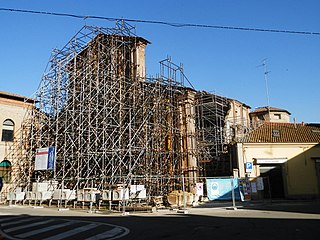
The church of San Francesco is a church located in Mirandola, in the province of Modena, Italy.
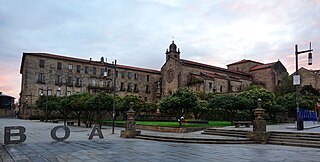
The Convent of St. Francis is a Franciscan convent located in the city centre of Pontevedra (Spain), overlooking the Plaza de la Herrería. The Gothic church of San Francis is attached to the convent on the southeast side.
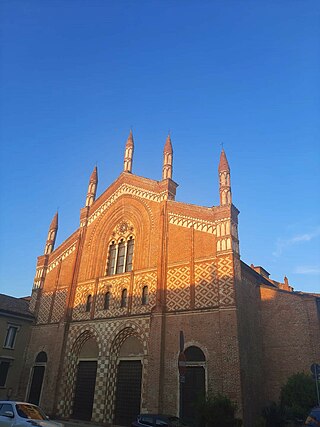
The church of San Francesco of Assisi is a Catholic religious building in Pavia, Lombardy, Italy.

The Basilica of St. Peter Alli Marmi is a Basilica comprising a church and a monastery. It is located in Eboli, 33 kilometers away from the city of Salerno, in Italy.

The temple of St. Francis is a Catholic place of worship in Gaeta, located in the historic center of the city, within the territory of the parish that lies over the cathedral of Saints Erasmus and Marcianus and St. Mary of the Assumption. The frescoes of the Temple of San Francesco were made by Vincenzo Petrocelli and Domenico Morelli.





























